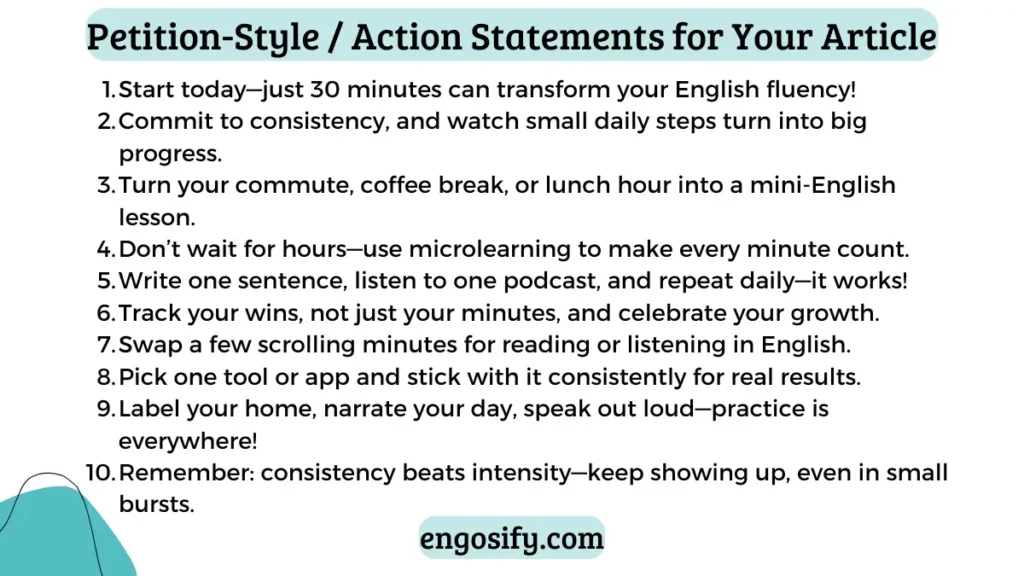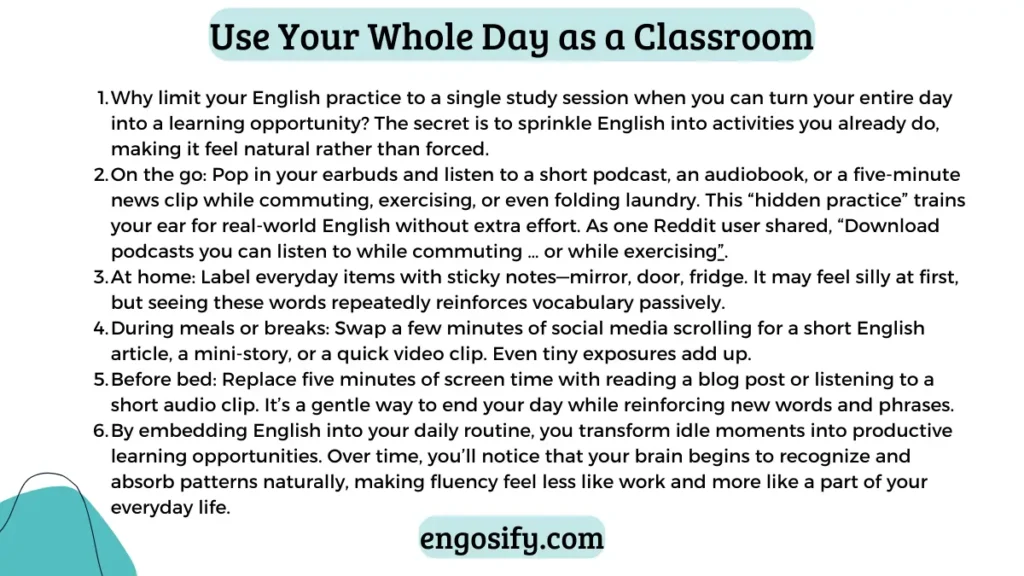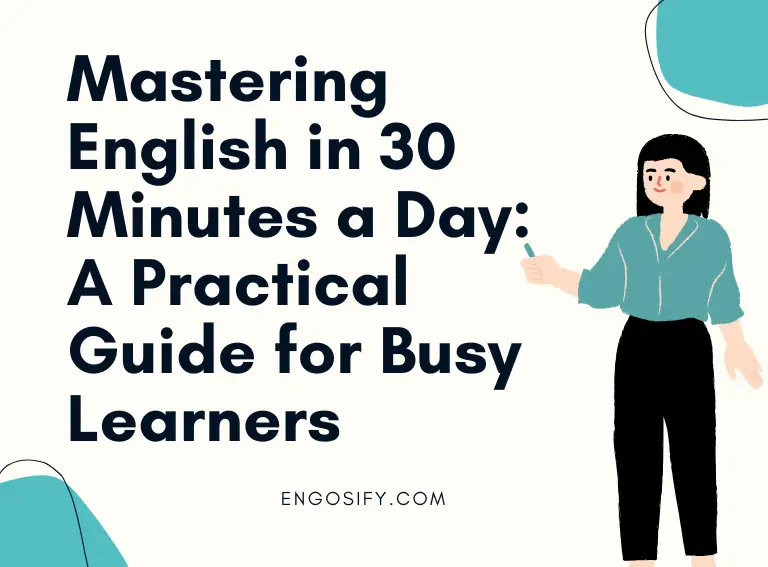We live in a world where time is gold, and let’s face it—most of us barely find a spare moment between work, family, and the endless to-do list. Yet, here’s the kicker: you don’t need hours locked away with a grammar book to improve your English. Just 30 minutes a day—yes, that’s all—can move the needle in a big way. Think of it as sneaking in a quick workout for your brain, one that fits neatly into your morning coffee break, commute, or evening wind-down.
This guide will walk you through a foolproof plan to maximize your learning without feeling overwhelmed. From structuring your short routine to picking tools that actually stick, you’ll see how small, consistent steps snowball into real progress. Plus, we’ll talk about ways to sneak English into your daily life without even realizing you’re studying. Ready? Let’s dive in!
Why 30 Minutes Daily Beats No Time at All
Here’s the truth: learning English isn’t about cramming until your brain feels like mashed potatoes—it’s about consistency. When you spend just half an hour each day, you’re building a habit that strengthens over time, much like watering a plant every morning instead of flooding it once a week.
Research on microlearning techniques shows that shorter, focused study sessions help you retain more because your brain processes chunks of information better. It’s like snacking instead of overeating—you digest more easily, and you don’t feel sluggish afterward. In fact, microlearning techniques are widely used in education and productivity training because they fit so well into busy lives.
Not only does this approach keep you motivated, but it also lowers the pressure. Missing a full two-hour study session feels like a disaster, right? But skipping 30 minutes once in a while? No big deal—you can bounce back the next day without losing momentum. That’s why busy learners who adopt this bite-sized method often stick with English longer and see faster results.

Structure Your 30-Minute Routine
So, how do you actually squeeze meaningful English practice into a mere half hour? The secret is breaking it down into mini-sessions that target different skills. Instead of staring at a book and zoning out, you’ll divide those 30 minutes into short bursts of energy—warm-up, focus, practice, and review. Think of it like a well-balanced meal: you’ve got your starter, main dish, side, and dessert.
1. Warm-up: 5 Minutes of Easy Input
Kick things off gently—don’t jump straight into tough grammar drills. For the first five minutes, just expose your ears or eyes to something light. That could be a short English podcast, a bite-sized YouTube tip, or even scrolling through a few sentences on a flashcard app while sipping your morning tea.
Why does this matter? Because warming up primes your brain, telling it, “Hey, it’s English time!” This little ritual also helps create habit-stacking—you attach study to something you already do, like your coffee routine. If you’re curious, you can check how habit stacking for learning works in other areas of life too.
2. Focus: 15 Minutes of Deliberate Practice
Now it’s time for the heavy lifting. Dedicate the next 15 minutes to focused, deliberate practice. Pick one area—vocabulary, grammar, or listening—and go deep, not wide.
For instance:
- Vocabulary building: use flashcards or write down 5 new words you’ve mined from native content.
- Grammar bite: review a single tense and write 2 sentences using it.
- Listening drill: replay one short clip and jot down new expressions.
This stage is your “main course.” It’s the moment you feed your brain with material that sticks. Studies on spaced repetition study methods prove that revisiting small chunks repeatedly boosts retention, so sprinkle in a little review from yesterday’s notes too. You can learn more about spaced repetition study methods to make this practice even more effective.
3. Apply: 10 Minutes of Speaking or Writing
Now, here’s where the magic happens. In the last chunk, turn passive knowledge into active use. Spend 10 minutes either speaking out loud or jotting down a quick text or journal entry.
Not sure what to talk about? Narrate your day as you cook, send yourself a voice note, or write a tiny diary entry: “Today I learned three new words: hustle, shortcut, and wrap up.” Boom—you’ve reinforced them. When you speak or write, your brain connects the dots faster, and before you know it, those phrases start rolling off your tongue naturally.
4. Review & Anchor: 5 Minutes to Reinforce
Finally, spend the last five minutes reviewing what you did. Read the sentences you wrote, replay the audio snippet, or glance over your new flashcards. This closing loop cements the day’s learning in memory.
Here’s the kicker: when you tie this 30-minute routine to an everyday habit—like commuting, lunch break, or winding down before bed—it transforms into second nature. And the best part? Over time, it won’t feel like studying at all—it’ll feel like a daily rhythm you can’t skip.
Picking the Right Materials: Native, Engaging, Short
Let’s be real—if your English practice feels like chewing cardboard, you won’t stick with it. That’s why choosing the right materials is crucial. Instead of burying yourself in long, dry textbooks, focus on native and practical content. Short, real-world material like blog posts, mini-articles, YouTube shorts, or even sitcom snippets can do wonders.
Why native? Because it exposes you to real English, not the overly simplified “classroom English” that sometimes feels artificial. The phrases, tone, and cultural expressions you’ll pick up are exactly what people use in everyday conversations. For example, watching a five-minute clip from your favorite show every night gives you authentic language, plus it keeps learning fun and light.
Oh, and here’s a golden tip: stick to one source per week. If you’re hopping between ten different shows, podcasts, and apps, you’ll scatter your attention. One focused choice beats ten scattered ones any day.
Best Apps and Platforms for 30-Minute Learners
Now, let’s talk tech. The right tools can turn those 30 minutes into pure gold. Apps like flashcard systems, podcast platforms, or structured language-learning sites can guide you when you’re not sure where to start.
If you love bite-sized lessons, platforms like EnglishClass101 or similar apps are designed for busy learners. They break down lessons into digestible chunks you can finish in 10 minutes flat—perfect for your “focus” stage. And if you’re more of a DIY learner, free resources like online dictionaries, subtitles, or spaced repetition systems can give you plenty of fuel for progress.
The trick isn’t downloading every flashy app on your phone—it’s picking one or two and actually using them consistently. Remember, learning tools are like gym memberships: they only work if you show up.
Avoid Burnout: Keep It Fun and Manageable
Here’s the deal: burnout is the sneaky villain that kills most language-learning journeys. You start strong, but after two weeks of grinding, you’re exhausted and tempted to throw in the towel.
How do you dodge that trap? Simple: keep it light and enjoyable. Don’t force yourself to memorize 50 words a day. Instead, stick to five new words, review them tomorrow, and use them in a sentence. Watch a funny clip you actually enjoy, not one you feel you “should” watch. If you’re laughing or curious, your brain absorbs faster.
Think of English like your favorite snack—it should be something you crave daily, not something you dread. And if you want some inspiration, exploring microlearning techniques from other fields can show you clever ways to keep things short and sweet without losing momentum.
Use Your Whole Day as a Classroom
Here’s the thing: your English practice doesn’t have to stop when the timer buzzes at 30 minutes. In fact, some of your biggest breakthroughs can happen while you’re just living your life. The trick is to sprinkle English into everyday activities so it feels less like “study” and more like part of your lifestyle.
- On the go: pop in your earbuds and listen to a short English podcast while commuting, exercising, or even folding laundry. This isn’t wasted time—it’s bonus input. As one clever learner put it on Reddit, “Download podcasts you can listen to while commuting … or while exercising.”
- At home: label your household items with sticky notes (“mirror,” “fridge,” “door”). It looks silly, but it works. Every glance reinforces vocabulary.
- During meals or breaks: skim through a short news article, read a menu in English, or watch a cooking clip.
- Before bed: swap 5 minutes of scrolling social media for reading an English blog post or a mini-story.
When you build these little rituals, your whole day becomes a classroom. And here’s the beauty of it: you’re not carving out extra time—you’re just transforming the time you already have.

Track What Counts – Not Just Time Spent
Now, let’s get real about motivation. Simply logging “30 minutes” every day can feel a bit hollow after a while. What keeps you fired up is tracking progress that matters.
Instead of asking, “How long did I study?”, ask:
- Did I learn 5 new words this week and actually use them?
- Could I understand more of that sitcom without subtitles compared to last month?
- Did I manage to write a few sentences with less hesitation?
This way, you’re measuring real growth, not just clocking hours. And here’s a bonus hack: keep a little “English wins” journal. Write down your small victories—like the first time you understood a meme in English or when a native speaker understood your joke. These tiny wins fuel your drive and remind you that consistency beats intensity.
When you track what counts, you stop worrying about perfection and start celebrating progress. That’s the mindset shift that keeps busy learners in the game long after the initial excitement fades.
Final Thoughts: Consistency Beats Intensity
At the end of the day, mastering English in 30 minutes a day isn’t about grinding harder—it’s about showing up consistently. Half an hour may not sound like much, but when you weave it into your routine and stick with it, the results sneak up on you. One week, you’re picking up a few new words; a few months later, you’re understanding entire conversations without breaking a sweat.
Remember this: progress doesn’t come from massive study marathons that leave you drained. It comes from the little daily steps that add up. Like drops filling a bucket, every short practice session builds your fluency.
So, keep it simple—warm up, focus, apply, and review. Use tools that you enjoy, blend English into your daily life, and track what truly matters. Most importantly, don’t chase perfection. Celebrate the small wins, and let those victories fuel your journey.
Because when it comes to language learning, consistency will always beat intensity. And guess what? With just 30 minutes a day, you’re already on the fast track.
FAQs
How much can I improve English with 30 minutes a day?
You’d be surprised! If you stick with a consistent 30-minute routine, you can see real improvement in just a few weeks. In the beginning, it might feel slow, but over time you’ll notice you can follow more conversations, remember more vocabulary, and express yourself with less hesitation. Think of it like working out—you don’t see six-pack abs overnight, but the daily effort compounds into visible results.
What if I miss a day—do I fall behind?
Absolutely not. Missing a single day won’t undo your progress. What matters is your overall habit. If life gets in the way, just pick up again the next day without guilt. Remember, consistency beats intensity. It’s better to keep showing up regularly—even with short sessions—than to pressure yourself with perfection.
Can listening during chores really help?
Oh, you bet it does! Passive listening might not teach you grammar rules directly, but it trains your ear to the rhythm and flow of English. Pop on a podcast while cleaning, cooking, or exercising, and you’ll start catching words and phrases naturally. In fact, learners often share on Reddit that these “hidden hours” are some of the most effective for building listening skills without extra effort.
What materials are best for busy learners?
Short, engaging, and native content works best. That could be sitcom clips, short news articles, YouTube videos, or even language apps designed for microlearning. The key is choosing material you enjoy—because if you like it, you’ll stick with it. Tools that follow microlearning techniques are especially helpful for squeezing practice into a packed schedule.
Conclusion
Mastering English in 30 minutes a day isn’t just possible—it’s practical. By breaking your study into small, focused steps, weaving English into daily life, and using tools you actually enjoy, you’ll build steady progress without burning out. Remember, it’s not about perfection or long hours—it’s about consistency.
Every podcast you listen to, every sentence you write, and every five minutes you review adds up. Over time, those small daily habits transform into fluency. So, grab your 30 minutes today, make it count, and let English become a natural part of your busy life.

